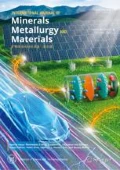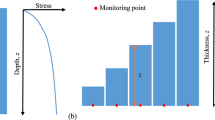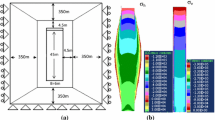Abstract
Voids (referred to as “stopes”) are generally created during underground mining activities and can lead to both local and regional geotechnical instabilities. To assist in managing the stability of mining-related voids and improving the recovery of orebodies, tailing-based backfill technology has been widely used around the world. In the design of tailing-based backfill strategy, the specific function and engineering requirements of the filling are intimately dependent on the stress distribution within the backfilled stope. In this paper, the main mechanics involved in tailing-based backfill in underground mines, which include arching, consolidation, hydration process, and movement of surrounding rocks, are reviewed. Research on the safety of a barricade and stability of an exposed fill face are also presented. In conclusion, the back-filling process should be performed on the basis of a better understanding of the complicated interactions of the mechanisms of filling, consolidation, and hydration process (when cement is added).
Similar content being viewed by others
References
Y. Potvin and E. Thomas, Handbook on Mine Fill, Australian Centre for Geomechanics, Perth, 2005.
M. Helinski, M. Fahey, and A. Fourie, Coupled two-dimensional finite element modelling of mine backfilling with cemented tailings, Can. Geotech. J., 47(2010), No. 11, p. 1187.
C.C. Qi, Big Data management in the mining industry, Int. J. Miner. Metall. Mater., 27(2020), p. 131.
E.F. Salmi, M. Nazem, and M. Karakus, The effect of rock mass gradual deterioration on the mechanism of post-mining subsidence over shallow abandoned coal mines, Int. J. Rock Mech. Min. Sci., 91(2017), p. 59.
T. Belem and M. Benzaazoua, Design, and application of underground mine paste backfill technology, Geotech. Geol. Eng., 26(2008), No. 2, p. 147.
N. Sivakugan, R.M. Rankine, K.J. Rankine, and K.S. Rankine, Geotechnical considerations in mine backfilling in Australia, J. Cleaner Prod., 14(2006), No. 12–13, p. 1168.
E. Yilmaz, T. Belem, and M. Benzaazoua, Study of physico-chemical and mechanical characteristics of consolidated and unconsolidated cemented paste backfills, Gospod. Surowcami Miner., 29(2013), No. 1, p. 81.
E. Yilmaz, A. Kesimal, and B. Erçikdi, The factors affecting strength and stability of paste backfill, Yerbilimleri, 28(2003), p. 155.
E. Yilmaz, Stope depth effect on field behaviour and performance of cemented paste backfills, Int. J. Min. Reclam. Environ., 32(2018), No. 4, p. 273.
C.C. Qi, A. Fourie, and Q.S. Chen, Neural network and particle swarm optimization for predicting the unconfined compressive strength of cemented paste backfill, Constr. Build. Mater., 159(2018), p. 473.
C.C. Qi and A. Fourie, Cemented paste backfill for mineral tailings management: Review and future perspectives, Miner. Eng., 144(2019), art. No. 106025.
B.D. Thompson, W.F. Bawden, and M.W. Grabinsky, In situ measurements of cemented paste backfill at the Cayeli Mine, Can. Geotech. J., 49(2012), No. 7, p. 755.
B.D. Thompson, M.W. Grabinsky, W.F. Bawden, and D.B. Counter, In-sttu measurements of cemented paste backfill in long-hole stopes, [in] ROCKENG09: Proceedings of the 3rd CANUS Rock Mechanics Symposium, Toronto, 2009, p. 199.
M. Aubertin, L. Li, S. Arnoldi, T. Belem, B. Bussière, M. Benzaazoua, and R. Simon, Interaction between backfill and rock mass in narrow stopes, Soil Rock Am., 1(2003), p. 1157.
M. Fahey, M. Helinski, and A. Fourie, Some aspects of the mechanics of arching in backfilled stopes, Can. Geotech. J., 46(2009), No. 11, p. 1322.
L. Li and M. Aubertin, Horizontal pressure on barricades for backfilled stopes. Part I: Fully drained conditions, Can. Geotech. J., 46(2009), No. 1, p. 37.
L. Cui and M. Fall, Multiphysics modeling of arching effects in fill mass, Comput. Geotech., 83(2017), p. 114.
H.A. Janssen, Versuche uber getreidedruck in silozellen, Z. Ver. Dtsch. Ing., 39(1895), No. 35, p. 1045.
A. Marston, The Theory of External Loads on Closed Conduits in the Light of the Latest Experiments, Iowa State College, Ames, 1930.
K. Terzaghi, Theoretical Soil Mechanics, John Wiley and Sons. Inc., New York, 1965.
C. Winch, Geotechnical Characteristics and Stability of Paste Backfill at BHP Cannington Mine [Dissertation], James Cook University, Townsville, 1999.
T. Belem, A. Harvey, R. Simon, and M. Aubertin, Measurement of internal pressures of a gold mine pastefill during and after the stope backfilling, [in] Proceedings of 5th International Symposium on Ground Support in Mining and Underground Construction, Perth, 2004, p. 619.
L. Li, M. Aubertin, and T. Belem, Formulation of a three dimensional analytical solution to evaluate stresses in backfilled vertical narrow openings, Can. Geotech. J., 42(2005), No. 6, p. 1705.
L. Li and M. Aubertin, Influence of water pressure on the stress state in stopes with cohesionless backfill, Geotech. Geol. Eng., 27(2009), No. 1, art. No. 1.
P. Rajeev, P.R. Sumanasekera, and N. Sivakugan, Average vertical stresses in underground mine stopes filled with granular backfills, Geotech Geol. Eng., 34(2016), No. 6, p. 2053.
S.D. Widisinghe, Stress Developments within a Backfilled Mine Stope and the Lateral Loading on the Barricade [Dissertation], James Cook University, Townsville, 2014.
J.E. Bowles, Foundation Analysis and Design, 5th ed., McGraw-Hill, New York, 1995.
K. Pirapakaran and N. Sivakugan, A laboratory model to study arching within a hydraulic fill stope, Geotech. Test. J., 30(2007), No. 6, p. 496.
M.A. Sobhi, L. Li, and M. Aubertin, Numerical investigation of earth pressure coefficient along central line of backfilled stopes, Can. Geotech. J., 54(2017), No. 1, p. 138.
A.B. Fourie, M. Helinski, and M. Fahey, Using effective stress theory to characterize the behaviour of backfill, [in] Proceedings of the Minefill Conference, Perth, 2007, p. 27.
L. Li and M. Aubertin, Numerical investigation of the stress state in inclined backfilled stopes, Int. J. Geomech., 9(2009), No. 2, p. 52.
R. Rankin, Geotechnical Characterisation and Stability of Paste Fill Stopes at Cannington Mine [Dissertation], James Cook University, Townsville, 2004.
M. Helinski, Mechanics of Mine Backfill [Dissertation], University of Western Australia, Perth, 2007.
R.E. Gibson, The progress of consolidation in a clay layer increasing in thickness with time, Geotechnique, 8(1958), No. 4, p. 171.
E. Yilmaz, T. Belem, B. Bussière, M. Mbonimpa, and M. Benzaazoua, Curing time effect on consolidation behaviour of cemented paste backfill containing different cement types and contents, Constr. Build. Mater., 75(2015), p. 99.
T. Belem, O. El Aatar, B. Bussiere, and M. Benzaazoua, Gravity-driven 1-D consolidation of cemented paste backfill in 3-m-high columns, Innov. Infrastruct. Solut., 1(2016), No. 1, art. No. 37.
M. Helinski, A. Fourie, M. Fahey, and M. Ismail, Assessment of the self-desiccation process in cemented mine backfills, Can. Geotech. J., 44(2007), No. 10, p. 1148.
L. Cui and M. Fall, Modeling of self-desiccation in a cemented backfill structure, Int. J. Numer. Anal. Methods Geomech., 42(2018), No. 3, p. 558.
H.Q. Jiang, M. Fall, and L. Cui, Yield stress of cemented paste backfill in sub-zero environments: Experimental results, Miner. Eng., 92(2016), p. 141.
J.M. Illston, J.M. Dinwoodie, and A.A. Smith, Concrete, Timber and Metals. The Nature and Behaviour of Structural Materials, Van Nostrand Reinhold, New York, 1979.
E. Rastrup, The temperature function for heat of hydration in concrete, [in] RELIM Symp.: Winter Concreting, Theory and Practice, Session B(II), Copenhagen, 1956.
L. Cui and M. Fall, A coupled thermo-hydro-mechanical-chemical model for underground cemented tailings backfill, Tunnelling Underground Space Technol., 50(2015), p. 396.
T.C. Powers and T.L. Brownyard, Studies of the physical properties of hardened Portland cement paste, J. Proc., 43(1946), No. 9, p. 101.
M. Walske, An Experimental Study of Cementing Paste Backfill [Dissertation], University of Western Australia, Perth, 2014.
R.E. Gibson, R.L. Schiffman, and K.W. Cargill, The theory of one-dimensional consolidation of saturated clays. II. Finite nonlinear consolidation of thick homogeneous layers, Can. Geotech. J., 18(1981), No. 2, p. 280.
M. Helinski, M. Fahey, and A. Fourie, Numerical modeling of cemented mine backfill deposition, J. Geotech. Geoenviron. Eng., 133(2007), No. 10, p. 1308.
M. Helinski, M. Fahey, and A. Fourie, Behavior of cemented paste backfill in two mine stopes: Measurements and modeling, J. Geotech. Geoenviron. Eng., 137(2010), No. 2, p. 171.
W.D. Carrier III, L.G. Bromwell, and F. Somogyi, Design capacity of slurried mineral waste ponds, J. Geotech. Eng., 109(1983), No. 5, p. 699.
O. Nasir and M. Fall, Modeling the heat development in hydrating CPB structures, Comput. Geotech., 36(2009), No. 7, p. 1207.
D. Wu, M. Fall, and S.J. Cai, Numerical modelling of thermally and hydraulically coupled processes in hydrating cemented tailings backfill columns, Int. J. Min. Reclam. Environ., 28(2014), No. 3, p. 173.
O. Nasir and M. Fall, Coupling binder hydration, temperature and compressive strength development of underground cemented paste backfill at early ages, Tunnelling Underground Space Technol., 25(2010), No. 1, p. 9.
L. Cui and M. Fall, Modeling of pressure on retaining structures for underground fill mass, Tunnelling Underground Space Technol., 69(2017), p. 94.
N. Falaknaz, M. Aubertin, and L. Li, Numerical investigation of the geomechanical response of adjacent backfilled stopes, Can. Geotech. J., 52(2015), No. 10, p. 1507.
A. Hasan, G. Suazo, J.P. Doherty, and A.B. Fourie, In situ measurements of cemented paste backfilling in an operating stope at Lanfranchi Mine, [in] Proceedings of the Eleventh International Symposium on Mining with Backfill, Perth, 2014, p. 20.
A. Hasan, G.H. Suazo, J. Doherty, and A. Fourie, In-stope measurements at two Western Australian mines, [in] Proceedings of 17th Int. Seminar on Paste and Thickened Tailing Paste 2014, Vancouver, 2014, p. 355.
C.C. Qi and A. Fourie, Numerical investigation of the stress distribution in backfilled stopes considering creep behaviour of rock mass, RockMech. Rock Eng., 52(2019), No. 9, p. 3353.
X. Zhao, A. Fourie, and C.C. Qi, An analytical solution for evaluating the safety of an exposed face in a paste backfill stope incorporating the arching phenomenon, Int. J. Miner. Metall. Mater., 26(2019), No. 10, p. 1206.
L. Li and M. Aubertin, A modified solution to assess the required strength of exposed backfill in mine stopes, Can. Geotech. J., 49(2012), No. 8, p. 994.
R.J. Mitchell, R.S. Olsen, and J.D. Smith, Model studies on cemented tailings used in mine backfill, Can. Geotech. J., 19(1982), No. 1, p. 14.
S. Zou and N. Nadarajah, Optimizing backfill design for ground support and cost saving, [in] Proceedings of Golden Rocks 2006: The 41st U.S. Symposium on Rock Mechanics (USRMS), Golden, Colorado, 2006.
A.P.E. Dirige, R.L. McNearny, and D.S. Thompson, The effect of stope inclination and wall rock roughness on back-fill free face stability, [in] Rock Engineering in Difficult Conditions: Proceedings of the 3rd Canada-US Rock Mechanics Symposium, Toronto, 2009.
A.P.E. Dirige and E. De Souza, Engineering design of backfill systems in adjacent pillar mining, [in] Proceedings of the 42nd U.S. Rock Mechanics Symposium (USRMS), Alexandria, 2008.
N.R. Morgenstern and V.E. Price, A numerical method for solving the equations of stability of general slip surfaces, Comput. J., 9(1967), No. 4, p. 388.
Z.Y. Chen and N.R. Morgenstern, Extensions to the generalized method of slices for stability analysis, Can. Geotech. J., 20(1983), No. 1, p. 104.
H.Z. Jiao, S.F. Wang, A.X. Wu, H.M. Shen, and J.D. Wang, Cementitious property of NaAlO2-activated Ge slag as cement supplement, Int. J. Miner. Metall. Mater., 26(2019), No. 12, p. 1594.
Y.Y. Tan, X. Yu, D. Elmo, L.H. Xu, and W.D. Song, Experimental study on dynamic mechanical property of cemented tailings backfill under SHPB impact loading, Int. J. Miner. Metall. Mater., 26(2019), No. 4, p. 404.
N.J.F. Koupouli, T. Belem, P. Rivard, and H. Effenguet, Direct shear tests on cemented paste backfill-rock wall and cemented paste backfill-backfill interfaces, J. Rock Mech. Geotech. Eng., 8(2016), No. 4, p. 472.
O. Nasir and M. Fall, Shear behaviour of cemented pastefill-rock interfaces, Eng. Geol., 101(2008), No. 3–4, p. 146.
M. Fall and O. Nasir, Mechanical behaviour of the interface between cemented tailings backfill and retaining structures under shear loads, Geotech. Geol. Eng., 28(2010), No. 6, p. 779.
K. Fang and M. Fall, Shear behavior of the interface between rock and cemented backfill: Effect of curing stress, drainage condition and backfilling rate, Rock Mech. Rock Eng., 53(2020), p. 325.
T. Belem, M. Benzaazoua, B. Bussiere, and A.M. Dagenais, Effects of settlement and drainage on strength development within mine paste backfill, [in] Proceedings of Tailings and Mine Waste ′02, Balkema, Rotterdam, 2002, p. 139.
K.A. Le Roux, W.F. Bawden, and M.W.F. Grabinsky, Assessing the interaction between hydration rate and fill rate for a cemented paste backfill, [in] Proceedings of the 55th Canadian Geotechnical and 3rd Joint IAH-CNC Groundwater Specialty Conference, Niagara Falls, Ontario, 2002, p. 427.
M. Fahey, M. Helinski, and A. Fourie, Development of specimen curing procedures that account for the influence of effective stress during curing on the strength of cemented mine backfill, Geotech. Geol. Eng., 29(2011), No. 5, p. 709.
M.B. Revell and D.P. Sainsbury, Paste bulkhead failures, [in] Proceedings of International Symposium of MineFill07, Montreal, 2007.
M.B. Revell and D.P. Sainsbury, Advancing paste fill bulkhead design using numerical modeling, [in] Proceedings of International Symposium of MineFill07, Montreal, 2007.
N. Sivakugan, K. Rankine, and R. Rankine, Permeability of hydraulic fills and barricade bricks, Geotech. Geol. Eng., 24(2006), No. 3, p. 661.
J. Li, J.V. Ferreira, and T. Le Lievre, Transition from discontinuous to continuous paste filling at Cannington Mine, [in] Proceedings of the 11th International Symposium on Mining with Backill, Preth, 2014, p. 381.
R.L. Veenstra, A Design Procedure for Determining the In Situ Stresses of Early Age Cemented Paste Backfill [Dissertation], University of Toronto, Toronto, 2013.
L. Li and M. Aubertin, Horizontal pressure on barricades for backfilled stopes. Part II: Submerged conditions, Can. Geotech. J., 46(2009), No. 1, p. 47.
A. Cheung, Influence of Rock Boundary Conditions on Behaviour of Arched and Flat Cemented Paste Backfill Barricade Walls [Dissertation], University of Toronto, Toronto, 2012.
S. Ghazi, Modeling of an Underground Mine Backfill Barricade [Dissertation], University of Toronto, Toronto, 2011.
Acknowledgement
The first author was financially supported by the China Scholarship Council (No. 201506420049).
Author information
Authors and Affiliations
Corresponding author
Rights and permissions
About this article
Cite this article
Zhao, X., Fourie, A. & Qi, Cc. Mechanics and safety issues in tailing-based backfill: A review. Int J Miner Metall Mater 27, 1165–1178 (2020). https://doi.org/10.1007/s12613-020-2004-5
Received:
Revised:
Accepted:
Published:
Issue Date:
DOI: https://doi.org/10.1007/s12613-020-2004-5




